EXCLAMATION
DAMSEL
Zoniagrion
exclamationis
|
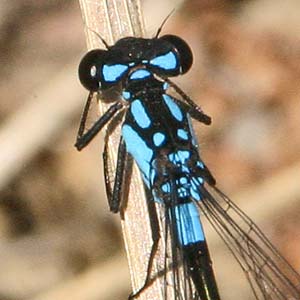 |
Exclamation Damsel is a bright
blue-and-black damselfly that is named for the pattern atop the thorax:
two pairs of a dash and a dot that look like two exclamation points ! !
It was just discovered in MTY in May 2007, so little is known about it
here.
|
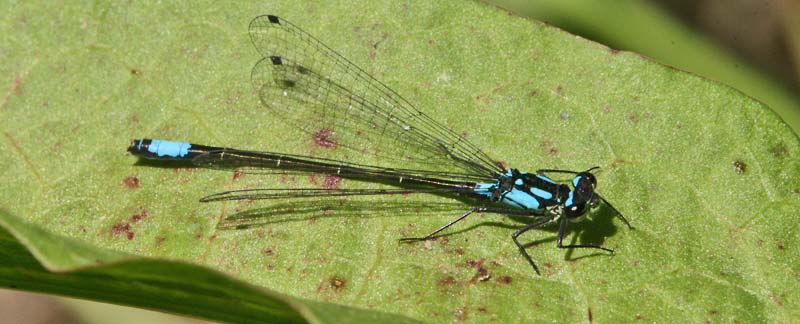
|
|
all photos 13 May
2007 Pajaro River MTY
|
|
|
|
Exclamation Damsel was discovered in
Monterey County because odites went looking for it. Don Roberson &
Rita Carratello (right), having traveled to Marin County in April to
see the species as a 'lifer,' and then learning in early May that Nick
Lethaby had discovered a population in coastal Santa Barbara County,
went searching for it locally on Mother's Day, 13 May. From habitat
tips provided by Nick Lethaby, and by Paul Johnson (who had seen it in
Santa Cruz city at a site suggested by Tim Manolis), Rita & Don
chose to try the MTY side of the Pajaro River. The river was too high
at the Thurwachter Bridge so they went upstream to the old railroad
trestle at the west end of Walker Street in Watsonville (above).
They were looking for a spot with dense
riparian along the river (right; trestle in the background) but also
with abundant hemlock. The weedy field on the MTY side (shown above)
has much hemlock and wild radish. These plants hosted many female and
younger damsels, while the adult males were in sunny patches within the
willows and sedge near the river. Here, Exclamation Damsel was by far
the commonest species, with ~40 estimated at the single locale. The
only other species noted were two Pacific Forktail (which is a smaller
damsel that looked rather 'tiny' next to Exclamations) and a couple of
Tule/Arroyo-type bluets.
|
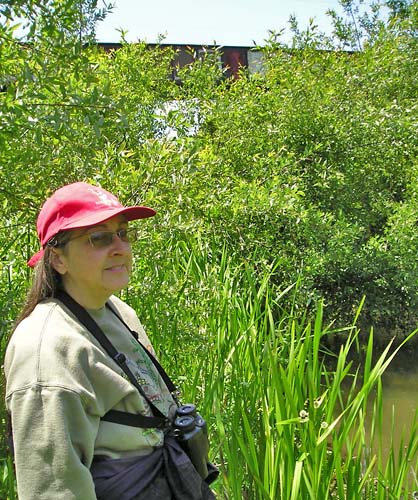
|
|
|
|
This was a breeding site; here's a tandem
mating pair (left).
The chosen habitat is eclectic. Biggs
(2006) gives the habitat as "mud-banked streams and ponds." Manolis
(2003) says: "quiet pools and backwaters of rivers and
streams and, occasionally, ponds bordered by willows (Salix),
alders (Alnus), and such. It is particularly associated with
sun-dappled, sylvan glades of blackberries (Rubus) and
herbaceous vegetation such as poison-hemlock (Conium maculatum),
mugwort (Artemisia doublasiana), and Queen Anne's lace (Daucus
corota)."
The Pajaro River is a badly abused habitat –
destroyed by governments for short-sighted 'flood control' – but here,
under the willows, it was indeed a "sun-dappled, sylvan glade."
|
|
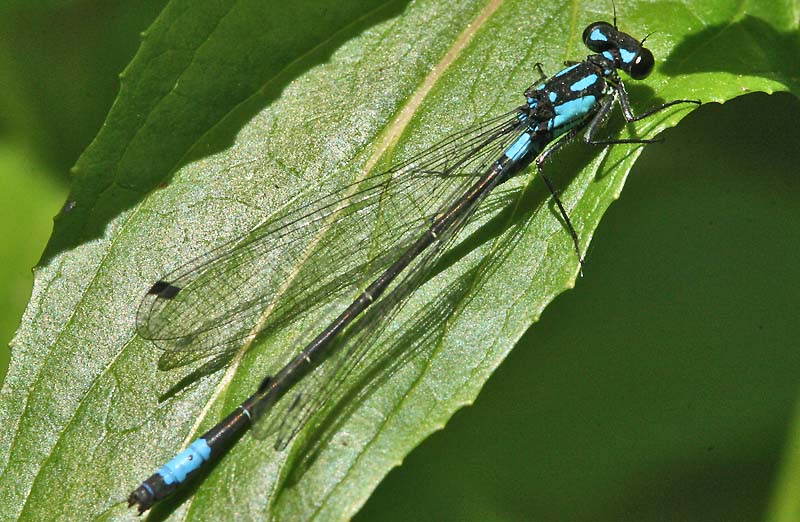
|
|
Male Exclamation Damsels are characterized not
only by the exclamation pattern on the thorax, but by triangle-shaped
blue eye spots, by an extensive blue patch near the end of the black
abdomen (covering the top of segments 7 through 9), blue also at the
base of the abdomen (segments 1 and 2), and by appendages that include
a long hook for each paraproct and short cerci with a 'fuzzy'
brush-like rear edge (below).

|
 |
| Female Exclamation Damsels are more
variable in pattern. Some (above) show the same type of exclamation
mark pattern atop the thorax as the male. Others, though, have the
'dash' and 'dot' merged together into a single long 'dash' (right and
below) but the 'dash' narrows where the merging occurs, producing a
mark that looks in shape like a baseball bat (to use the description
given by Manolis 2003). They are also variable in color, ranging from
pale green (younger ones) to pale blue to a purplish-blue (older ones).
Note that females have less blue at the tip of the abdomen, covering
only the top of segments 7 and 8, and they lack the male's appendages. |
|
|
|
|
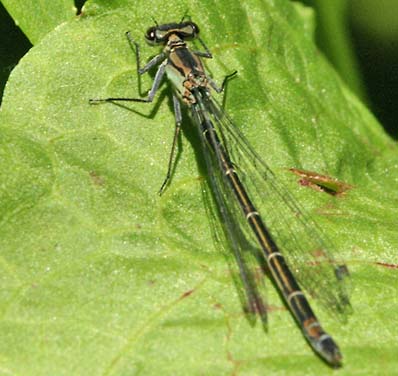 |
Very young females can be mostly coppery-tan
and pale green (left) but they still show either the exclamation marks
or the 'baseball bat' pattern to the top of the thorax.
This species is in its own unique genus – Zoniagrion
– and is a California endemic !! It ranges from
Mendocino and Shasta counties south to its just-discovered southern
limit in Santa Barbara County. It was only recently found in San Benito
Co. and, now, in Monterey County.
One story I've heard is that when the
committee that gave English names to odonates considered this species
in the 1990s, they almost named it something entirely inappropriate,
like "Sierra Damsel." Horrors! It is not a Sierran specialist but
occurs near the coast in many locales (including MTY).
Fortunately, Kathy Biggs proposed "Exclamation Damsel" and the day was
won!
|
|
|
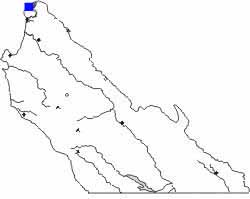 The map shows the only known site for
Exclamation Damsel so far within the county: the MTY side of the Pajaro
River within the town of Pajaro. It occurs in similar sites in Santa
Cruz County, and further surveys may find it elsewhere in Monterey
County. The map shows the only known site for
Exclamation Damsel so far within the county: the MTY side of the Pajaro
River within the town of Pajaro. It occurs in similar sites in Santa
Cruz County, and further surveys may find it elsewhere in Monterey
County.
Exclamation Damsel is an early flier.
Elsewhere, it occurs from March into August (Manolis 2003). The peak
dates seem to be primarily in April-May (K. Biggs), and so far the MTY
date (13 May) is consistent with the peak time.
|
|
Literature cited:
- Biggs, K. 2006. Dragonflies of California: A
Beginner's Pocket Guide. Azalea Creek Publ., Sebastopol, CA.
- Manolis, T. 2003. Dragonflies and Damselflies of
California. Univ. of Calif. Press, Berkeley.
Web resources:
Major identification web sites with much information on California
odes include:
For sites with excellent photos to compare for identification or to
simply
enjoy, see:
Many of these sites have links to other useful pages. Kathy Biggs's
site
is particularly useful in her selection of links. |
